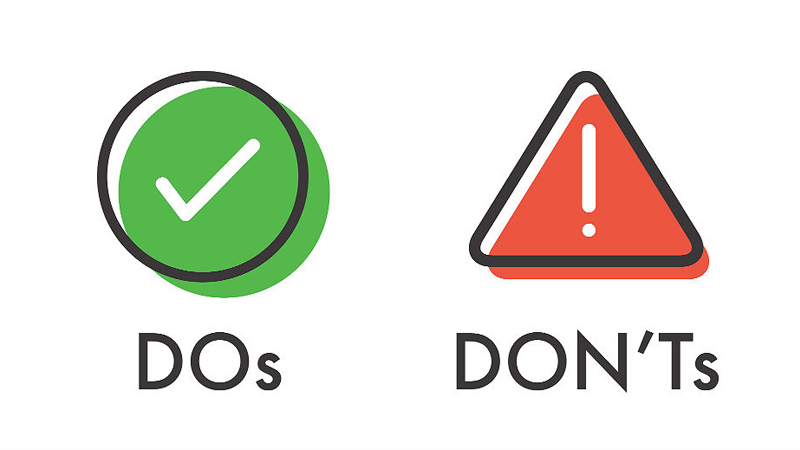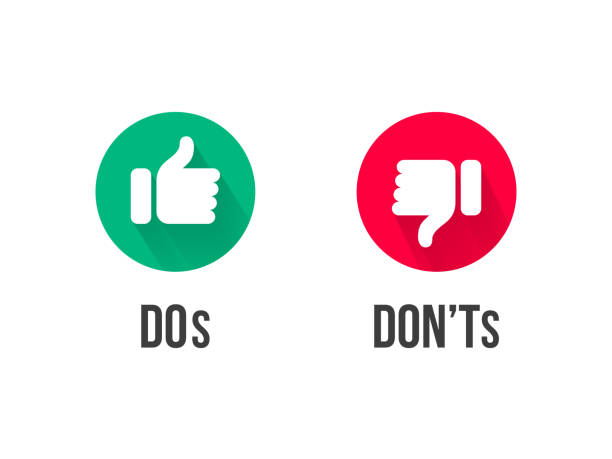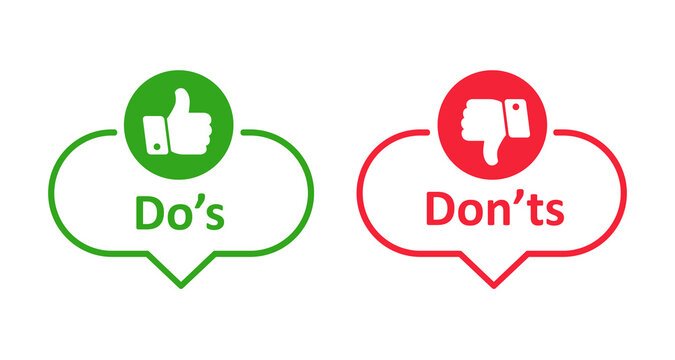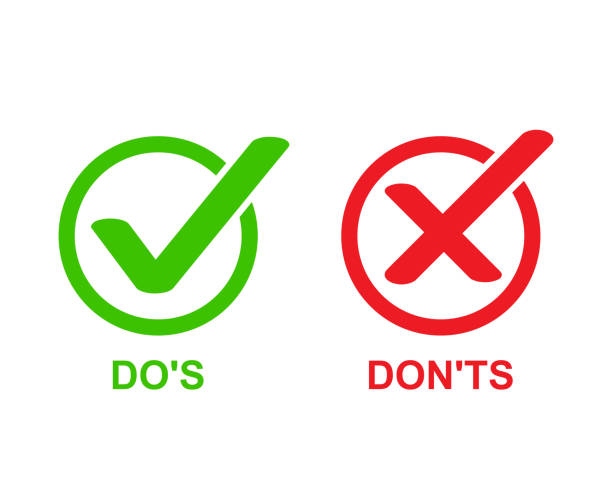Understanding the dos and don’ts can make a huge difference. It helps avoid mistakes and ensures success.
Navigating through life and work involves making countless decisions. Some lead to success, while others may result in setbacks. Knowing the right actions to take, as well as the ones to avoid, is crucial. This guide will highlight key dos and don’ts to help you achieve your goals.
Whether you’re looking to improve your personal life or professional career, these tips can provide clear direction. Following these simple guidelines can help you stay on track and avoid common pitfalls. Let’s dive into the essential dos and don’ts that can make a positive impact on your journey.

Credit: www.goarch.org
Importance Of Communication
When we talk about personal and professional success, communication stands out as a crucial skill. Effective communication can open doors, foster relationships, and drive career growth. Understanding the dos and don’ts of communication can significantly impact your journey. Let’s delve into why communication is so important.
Building Relationships
Good communication is the cornerstone of building relationships. Whether with friends, family, or colleagues, how you communicate can make or break these connections.
Consider a time when you had a misunderstanding with a friend. Did it stem from poor communication? Often, it does. Clear, concise communication can prevent conflicts and strengthen bonds. Expressing your thoughts and listening actively are essential.
- Do: Listen actively. Show that you care about what the other person is saying.
- Don’t: Interrupt or assume you know what they mean without clarifying.
Active listening can be as simple as nodding your head or asking follow-up questions. These small gestures show respect and understanding, crucial elements for any relationship.
Enhancing Career Growth
Effective communication is a key driver of career growth. It allows you to express your ideas clearly and collaborate with others efficiently.
Imagine presenting a project proposal to your boss. Your ability to communicate your vision can determine the project’s success and your career trajectory. Clear articulation of ideas can set you apart in a competitive workplace.
- Do: Prepare and practice your communication. Know your audience and tailor your message accordingly.
- Don’t: Overcomplicate your message. Avoid jargon that might confuse your listener.
Communication isn’t just about talking; it’s about ensuring your message is received as intended. Preparing and practicing can significantly enhance how your ideas are perceived.
So, how are you planning to improve your communication skills? Think about the relationships and career opportunities you could unlock with better communication. Your journey starts now.
Remember, communication is a two-way street. Listening is just as important as speaking. Commit to understanding and being understood, and you’ll find success in both your personal and professional life.
Active Listening
Active listening involves maintaining eye contact and nodding to show understanding. Avoid interrupting or letting your mind wander. Focus on the speaker and respond thoughtfully.
Active listening is more than just hearing words. It’s about understanding the message behind those words. When you actively listen, you fully concentrate, understand, respond, and then remember what is being said. This skill is crucial in both personal and professional settings, fostering deeper connections and minimizing misunderstandings. Let’s explore how you can hone this skill with some practical techniques and also avoid common mistakes.Techniques To Improve
Improving your active listening skills can be simple with a few effective techniques:- Maintain Eye Contact: Show the speaker you are engaged. This doesn’t mean staring them down but rather demonstrating attentiveness.
- Nod and Use Verbal Acknowledgements: Small cues like nodding or saying “I see” or “Go on” encourage the speaker to continue.
- Paraphrase and Summarize: Repeat back what you’ve heard in your own words. This shows you’re listening and helps clarify any misunderstandings.
- Ask Open-Ended Questions: Questions that require more than a yes or no answer prompt deeper conversation and understanding.
- Minimize Distractions: Put away your phone, close your laptop, and focus on the conversation. Distractions can make the speaker feel unimportant.
Common Pitfalls
Even with the best intentions, there are common pitfalls that can hinder active listening:- Interrupting: Cutting someone off can disrupt their train of thought and make them feel disrespected. Let them finish before you respond.
- Jumping to Conclusions: Avoid assuming you know what the speaker is going to say next. This can lead to misunderstandings.
- Offering Unsolicited Advice: Sometimes, people just need to be heard rather than given solutions. Ask if they want your advice before offering it.
- Getting Distracted: Thinking about what you’ll say next or getting lost in your thoughts means you’re not fully listening. Stay present.
- Being Judgmental: Criticizing or making judgments can close off communication. Listen with an open mind.
Clear And Concise Messaging
Crafting clear and concise messaging involves using short, direct sentences. Avoid jargon and keep your audience in mind.
Clear and Concise Messaging Clear and concise messaging is the backbone of effective communication. It ensures your readers understand your message without getting lost in unnecessary details. When your message is straightforward, it resonates more and leaves a lasting impact.Avoiding Jargon
Using jargon can alienate readers. Technical terms may seem impressive, but they often confuse and frustrate people who aren’t familiar with them. Imagine explaining a technical concept to your grandmother. Would she understand it? If the answer is no, then it’s time to simplify. Instead of saying, “We need to leverage synergies,” try saying, “We need to work together.” This makes your message clear and accessible.Using Simple Language
Simple language is powerful. It breaks down barriers and makes your message relatable. When I started writing, I used complex words, thinking it made me sound smart. But readers struggled to understand. I learned that simplicity wins every time. Use short sentences. Avoid passive voice. Speak directly to your readers. This approach keeps your message clear and engaging. Example: Complicated: The implementation of the new system will be facilitated by our team. Simple: Our team will help set up the new system. Do you see the difference? Simple language makes your message stronger. Remember, clear and concise messaging is about making connections. You want your readers to understand and engage with your content. Avoid jargon and use simple language to keep your message crystal clear.
Credit: www.istockphoto.com
Non-verbal Cues
Non-verbal cues play a crucial role in communication. They often convey more than words and can greatly impact how your message is received. Understanding the dos and don’ts of non-verbal communication can enhance your interactions significantly. Let’s delve into two key aspects: body language and facial expressions.
Body Language
Body language speaks volumes. It can show confidence, interest, or even discomfort. Here are some dos and don’ts to keep in mind:
- Do: Maintain an open posture. Stand tall with shoulders back to project confidence.
- Do: Use hand gestures to emphasize points. They make your communication more engaging.
- Do: Make appropriate eye contact. It shows you are attentive and interested.
- Don’t: Cross your arms. This can be perceived as defensive or closed off.
- Don’t: Fidget excessively. It can be distracting and may suggest nervousness.
- Don’t: Invade personal space. Respecting boundaries is key to comfortable interactions.
Imagine you’re in a job interview. You sit with an open posture and maintain eye contact. This shows you’re confident and engaged. In contrast, crossing your arms and avoiding eye contact might give the impression that you’re disinterested or insecure. Which impression would you prefer to make?
Facial Expressions
Facial expressions are powerful. They can express a range of emotions and complement your words. Here are some essential dos and don’ts:
- Do: Smile genuinely. A smile can make you appear friendly and approachable.
- Do: Nod occasionally. It shows you are listening and understanding.
- Do: Maintain a relaxed face. Tension can signal stress or discomfort.
- Don’t: Overdo facial expressions. Exaggerated expressions can seem insincere.
- Don’t: Roll your eyes. This is universally seen as disrespectful.
- Don’t: Frown unnecessarily. It can give off a negative vibe.
Consider a time when you received positive feedback. Smiling and nodding likely made the giver feel appreciated. Conversely, a frown or lack of expression might have made them question their words. How do you think your expressions affect others?
Understanding and mastering these non-verbal cues can greatly improve your communication. Are you ready to pay more attention to your body language and facial expressions?
Empathy In Communication
Empathy in communication is vital for building strong relationships. It helps us understand others and respond effectively. When we communicate with empathy, we show we care. This strengthens connections and creates a positive environment.
Understanding Others
To communicate with empathy, first understand others. Listen to their words and observe their body language. This helps you grasp their feelings and thoughts. Pay attention to their tone of voice. It can reveal their true emotions.
Ask questions to clarify their views. This shows you are interested in their perspective. Avoid interrupting when they speak. Give them the space to express themselves fully. This builds trust and respect.
Responding Effectively
Responding effectively means acknowledging their feelings. Use phrases like “I understand” or “That sounds difficult.” This shows you recognize their emotions. It’s important to be genuine in your responses.
Offer support or solutions if they seek advice. Sometimes, just listening can be enough. Avoid dismissing their feelings or giving unsolicited advice. This can make them feel unheard or undervalued.
Use positive body language. Nodding and maintaining eye contact can show you are engaged. Your actions should match your words. This reinforces your empathy and builds a stronger connection.

Credit: stock.adobe.com
Confidence Building
Building confidence involves practicing good posture and maintaining eye contact. Avoid negative self-talk and comparing yourself to others.
### Confidence Building Building confidence can be a challenging but incredibly rewarding journey. Whether you’re preparing for a big presentation or simply aiming to be more assertive in your daily interactions, boosting your confidence can make a huge difference. Let’s dive into some practical strategies to help you build confidence, focusing on overcoming fear and the importance of practice and preparation.Overcoming Fear
Fear is a common obstacle on the path to confidence. It can hold you back from taking important steps in your personal and professional life. Overcoming fear starts with acknowledging it. The next time you feel that knot in your stomach, ask yourself: What exactly am I afraid of? When I first started public speaking, I was terrified of forgetting my lines. To address this, I began to visualize the worst-case scenario and how I could handle it. Surprisingly, this reduced my anxiety because I realized that even if things went wrong, I could recover. Break down your fears into manageable chunks: – Identify what scares you most. – Challenge the negative thoughts associated with those fears. – Create a plan for how you would handle the situation if things didn’t go as planned. Taking small steps to face your fears can make a big difference. Each time you push through, you’ll build a little more confidence.Practice And Preparation
You’ve probably heard the saying, “Practice makes perfect.” While perfection might be unattainable, practice certainly makes you better. When you prepare thoroughly, your confidence naturally increases. Consider the story of a friend who had to deliver a presentation to a large audience. She practiced her speech multiple times, not just in front of a mirror but also in front of friends and family. This not only helped her refine her delivery but also made her feel more comfortable with the material. Here’s how you can effectively practice: – Rehearse in different settings: Try presenting in different environments to get used to various scenarios. – Record yourself: Watching a video of your practice sessions can help you notice areas for improvement. – Seek feedback: Ask for constructive feedback from people you trust. Preparation also means being ready for the unexpected. Have a plan B. If you’re giving a presentation, know your material so well that you can adapt if technology fails. Questions to consider: – Have you practiced enough to feel comfortable? – What’s your backup plan if things don’t go as expected? By addressing these questions, you ensure you’re not just prepared but also adaptable, further boosting your confidence. Building confidence doesn’t happen overnight. It’s a continuous process of overcoming fears and preparing diligently. With each step forward, you’ll find yourself becoming more self-assured and ready to tackle new challenges.Handling Conflict
Addressing conflicts requires calm communication and active listening. Avoid blaming and interrupting others. Seek solutions together, respecting different viewpoints.
Handling conflict can be challenging, but it is an inevitable part of life. Whether at work, home, or in social situations, knowing how to navigate these moments with grace and effectiveness is crucial. In this post, we will explore key strategies for handling conflict, ensuring you stay calm and find solutions that work for everyone involved. Let’s dive into the dos and don’ts of managing conflict effectively.Staying Calm
When faced with conflict, staying calm is essential. Losing your cool can escalate the situation and make finding a resolution more difficult. Take a deep breath and try to keep your emotions in check. Do: – Take a moment to breathe: If you feel your anger rising, pause and take a few deep breaths. This simple act can help you regain composure. – Listen actively: Focus on understanding the other person’s perspective without immediately jumping in to defend yourself. This shows respect and can de-escalate tension. – Speak in a calm tone: Your tone of voice can significantly impact the conversation. Keep it steady and avoid raising your voice. Don’t: – Interrupt: Cutting the other person off can make them feel unheard and increase frustration. – Blame or accuse: Pointing fingers can put the other person on the defensive, hindering constructive dialogue. – Let emotions control you: Acting out of anger or frustration can lead to regretful actions or words. Remember a time when you managed to stay calm during a heated discussion. Perhaps it was at work when a colleague criticized your project. By staying calm and listening, you may have found common ground and improved the outcome.Finding Solutions
Conflict resolution isn’t just about addressing the current issue; it’s about finding solutions that prevent future problems. This requires a collaborative approach where both parties feel heard and valued. Do: – Identify the root cause: Dig deeper to understand what’s truly causing the conflict. Sometimes, it’s not the surface issue but underlying feelings or needs. – Brainstorm together: Involve the other person in finding a solution. This can lead to more creative and acceptable outcomes. – Be willing to compromise: Flexibility is key. Find a middle ground that satisfies both parties to some extent. Don’t: – Stick rigidly to your viewpoint: Insisting on your way can stall the resolution process. – Ignore the other person’s feelings: Acknowledge their emotions and validate their concerns. – Seek to win: Conflict resolution isn’t about winning; it’s about finding a mutually beneficial outcome. Consider a situation where you had to find a solution with a friend over a disagreement on vacation plans. By understanding each other’s preferences and compromising, you could create a plan that made both of you happy. Handling conflict with calmness and a solution-oriented mindset can transform how you navigate disagreements. How will you apply these strategies in your next conflict situation?Feedback Mechanisms
Feedback mechanisms are vital for growth and improvement. They help us understand our strengths and areas for improvement. Knowing how to give and receive feedback effectively is crucial. Let’s explore some dos and don’ts of feedback mechanisms.
Giving Constructive Criticism
When giving feedback, focus on the behavior, not the person. Use specific examples to illustrate your points. This makes your feedback clear and actionable. Be honest but kind. Avoid using harsh or judgmental language. Your goal is to help, not hurt.
Offer solutions or suggestions for improvement. This shows you care about their progress. It’s also important to balance negative feedback with positive comments. Recognize what they did well. This boosts their confidence and encourages them to keep improving.
Receiving Feedback Gracefully
Receiving feedback can be challenging. It requires an open mind and willingness to improve. Listen carefully without interrupting. Understand the feedback before reacting. Ask questions if something is unclear.
Stay calm and composed. Avoid getting defensive or taking it personally. Remember, feedback is a tool for growth. Thank the person for their input. Show appreciation for their effort in helping you improve.
Frequently Asked Questions
Is Do’s And Don Ts Correct?
No, “do’s and don’ts” is the correct form. Use apostrophes for clarity and readability.
What Are The Do’s And Don’ts?
Do: Plan ahead, stay organized, communicate clearly, and be respectful. Don’t: Procrastinate, ignore feedback, overcommit, or be disrespectful.
What Does Dos Don’ts Mean?
“Dos and don’ts” refer to rules or guidelines about what should and shouldn’t be done in a specific situation.
Where Does The Apostrophe Go In Don’ts?
The apostrophe in “Don’ts” goes after the “n” and before the “t”. It forms the contraction for “do not”.
Conclusion
Remember the dos and don’ts to improve your success. Following guidelines ensures better results. Avoid common mistakes to stay ahead. Take small steps for consistent growth. Focus on clear goals and strategies. Learn from past experiences. Keep refining your approach.
Aim for progress, not perfection. Regularly review and adjust your methods. Stay committed and patient. Success comes with persistence and smart work.
{ “@context”: “https://schema.org”, “@type”: “FAQPage”, “mainEntity”: [ { “@type”: “Question”, “name”: “Is do’s and don ts correct?”, “acceptedAnswer”: { “@type”: “Answer”, “text”: “No, \”do’s and don’ts\” is the correct form. Use apostrophes for clarity and readability.” } } , { “@type”: “Question”, “name”: “What are the do’s and don’ts?”, “acceptedAnswer”: { “@type”: “Answer”, “text”: “Do: Plan ahead, stay organized, communicate clearly, and be respectful. Don’t: Procrastinate, ignore feedback, overcommit, or be disrespectful.” } } , { “@type”: “Question”, “name”: “What does dos don’ts mean?”, “acceptedAnswer”: { “@type”: “Answer”, “text”: “\”Dos and don’ts\” refer to rules or guidelines about what should and shouldn’t be done in a specific situation.” } } , { “@type”: “Question”, “name”: “Where does the apostrophe go in Don’ts?”, “acceptedAnswer”: { “@type”: “Answer”, “text”: “The apostrophe in \”Don’ts\” goes after the \”n\” and before the \”t\”. It forms the contraction for \”do not\”.” } } ] }



